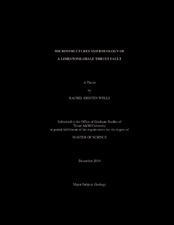| dc.description.abstract | The Copper Creek thrust fault in the southern Appalachians places Cambrian
over Ordovician sedimentary strata. The fault accommodated displacement of 15-20 km
at 100-180 °C. Along the hanging wall-footwall contact, microstructures within a ~2 cm
thick calcite and shale shear zone suggest that calcite, not shale, controlled the rheology
of the shear zone rocks. While shale deformed brittley, plasticity-induced fracturing in
calcite resulted in ultrafine-grained (<1.0 μm) fault rocks that deformed by grain
boundary sliding (GBS) accommodated primarily by diffusion creep, suggesting low
flow stresses.
Optical and electron microscopy of samples from a transect across the footwall
shale into the shear zone, shows the evolution of rheology within the shear zone.
Sedimentary laminations 1 cm below the shear zone are cut by minor faults, stylolites,
and fault-parallel and perpendicular calcite veins. At vein intersections, calcite grain
size is reduced (to ~0.3 μm), and microstructures include inter-and-intragranular
fractures, four-grain junctions, and interpenetrating boundaries. Porosity rises to 6 percent
from <1 percent in coarse (25 μm) areas of calcite veins. In coarse-grained calcite, trails of voids follow twin boundaries, and voids occur at twin-twin and twin-grain boundary
intersections.
At the shear zone-footwall contact, a 350 μm thick calcite band contains coarseand
ultrafine-grained layers. Ultrafine-grained (~0.34 μm) layers contain
microstructures similar to those at vein intersections in the footwall and display no
lattice-preferred orientation (LPO). Coarse-grained layers cross-cut grain-boundary
alignments in the ultrafine-grained layers; coarse grains display twins and a strong LPO.
Within the shear zone, ultrafine-grained calcite-aggregate clasts and shale clasts (5-350
μm) lie within an ultrafine-grained calcite (<0.31 μm) and shale matrix. Ultrafinegrained
calcite (<0.31 μm) forms an interconnected network around the matrix shale.
Calcite vein microstructures suggest veins continued to form during deformation.
Fractures at twin-twin and twin-grain boundary intersections suggest grain size reduction
by plasticity-induced fracturing, resulting in <1 μm grains. Interpenetrating boundaries,
four-grain junctions, and no LPO indicate the ultrafine-grained calcite deformed by
viscous grain boundary sliding. The evolution of the ultrafine-grain shear zone rocks by
a combination of plastic and brittle processes and the deformation of the interconnected
network of ultrafine-grained calcite by viscous GBS enabled a large displacement along
a narrow fault zone. | en |


